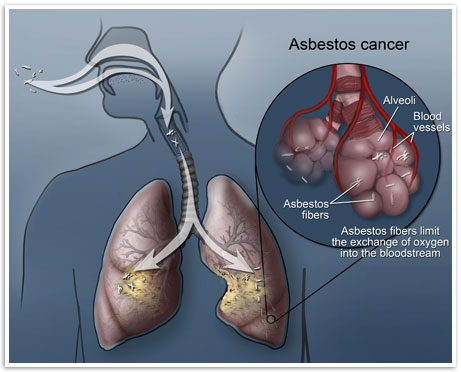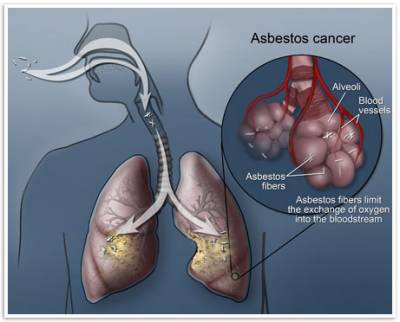
- 13.09.2014
- 3356 Просмотров
- Обсудить
Asbestos cancer is more commonly known as mesothelioma.
Mesothelioma, the type of cancer most commonly associated with asbestos exposure, is a malignancy that occurs in the lining of the lungs, abdomen, and heart. A mesothelioma diagnosis is generally classified as one of the following three types: pleural mesothelioma which occurs in the lining of the lungs (known as the pleura); peritoneal mesothelioma which occurs in the lining of the abdominal cavity (known as the peritoneum); and pericardial mesothelioma which occurs in the lining of the heart (known as the pericardium).
Asbestos, which has been used for, quite literally, thousands of years as a fire-retardant and insulation material has long been connected to sickness, though not necessarily cancer until the last 50 years. Once asbestos was classified as a known carcinogen, the Environmental Protection Agency and Consumer Product Safety Commission imposed strict regulations on its use in commercial and industrial products. Unfortunately, many of the companies producing asbestos products were well aware of the hazards which asbestos posed and continued to expose workers and laborers to the harmful asbestos fibers.
The diagnosis of asbestos cancer is often difficult due to the symptoms of the disease mimicking those of other illnesses.
Asbestos cancer diagnosis, including diagnosis of mesothelioma and lung carcinoma, can be difficult because symptoms of the disease can closely mimic those of other, more minor, respiratory complications. Symptoms, such as shortness of breath, chest pain, or chronic cough, may lead physicians to suspect mesothelioma, particularly if the patient has a known asbestos exposure history.
Diagnostic tools include CT scans and MRIs for patients where asbestos cancer is suspected. In most cases, these imaging scans will be able to provide a picture of the tumor, but a biopsy will likely be required to determine a conclusive diagnosis of mesothelioma rather than other lung carcinomas. In cases where pleural or peritoneal effusions have manifested in the patient, draining these and extracting the fluid through pleurocentesis can allow oncologists to test the fluid for the presence of malignant cells.
Asbestos Cancer Treatment
Asbestos cancer treatment options typically include some combination surgery, chemotherapy, and radiation
Depending on the location of the cancer, generally asbestos related malignancies can be difficult to resect because the latency period over which the cancer goes undetected can often extend into the time period where the tumor develops through its preliminary stages. Later stage cancers, and particularly those related to asbestos, will often not be resectable malignancies. While diagnosis of early stage asbestos cancer is uncommon, certainly those eligible for surgical removal will often have the cancer resected. Adjuvant chemotherapy is often administered after surgery to complement the resection.
Pleurectomy and extrapleural pneumonectomy, both extensive surgeries, are often used in the treatment of pleural asbestos cancer. Surgery is much less common in malignant peritoneal and pericardial cancer, as the origin of the tumor is difficult to access without endangering the survival of the patient.
Chemotherapy is the most frequently utilized treatment mechanism for the control of asbestos cancer. Drugs like Alimta®, Cisplatin, and Gemcitabine have all been used with varying degrees of efficacy to halt or slow the spread of malignant mesothelioma and lung carcinomas. Ongoing clinical trials continue to test new drugs and drug cocktails for the management and treatment of asbestos cancer. Recent trends suggest that researchers are making strides in determining approved treatment regimens not only for malignant pleural mesothelioma, but also peritoneal and pericardial cancers.
Currently, the only FDA-approved chemotherapy regimen for the asbestos cancer malignant pleural mesothelioma is a combination of Alimta® and Cisplatin, delivered intravenously, with 21 days between each subsequent injection. Asbestos lung cancer carcinomas are also treatable with chemotherapy. Because asbestos cancer incidence of this type is much more prevalent (and not necessarily directly attributable to asbestos exposure), there are many more chemotherapy options available to patients.
External beam radiation is popular among patients receiving treatment for pleural and peritoneal cancer. Pericardial cancer patients may also utilize radiation in the control of their cancer, but in lower dosages considering the region's proximity to the heart. Radiation therapy is considered useful for palliation as well to prevent malignant cells from taking hold again following surgery.
As part of developing studies into the control of asbestos cancer through radiotherapy, researchers have begun utilizing brachytherapy to control mesothelioma tumor spread and growth. Brachytherapy is an internal radiation source implanted in the affected area which has shown promise in clinical studies in reducing tumor mass and slowing. Every year, survival rates are extended further and more funding is now being invested in research to evaluate new options for treatment. Researchers hope to, one day, find a cure for mesothelioma.
Compensation for Asbestos Cancer
Many asbestos cancer patients have successfully collected compensation from asbestos companies responsible for their exposure.
Unfortunately, it has come to light in recent years that many manufacturers of asbestos products were fully aware of the harmful nature of asbestos fibers and continued to expose hundreds of thousands of laborers to the toxic mineral. Asbestos products were prevalent in naval shipyards, power plants, oil refineries, and in ventilation/steam fixtures. Asbestos was also common in home construction materials, automobile parts, and thousands of other products.
Fortunately, you may be eligible for financial compensation if you have been diagnosed with asbestos-related cancer or other injury. While prognosis for asbestos related cancer is often poor, those who have been exposed negligently are able to secure compensation for their treatment as well as for their families in their battle with terminal disease. If you or a loved one has been diagnosed with mesothelioma or other asbestos disease, we urge you to fill out the brief form on this page. We'll send you an up-to-date information packet on new treatment options for mesothelioma, how to obtain compensation for your injuries, and important timelines associated with legal recourse for asbestos cancer patients.
Будь-те первым, поделитесь мнением с остальными.

